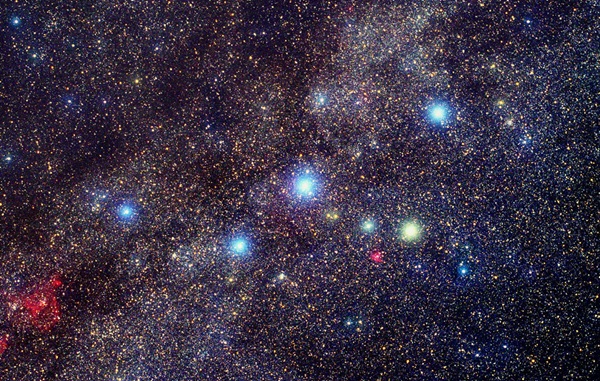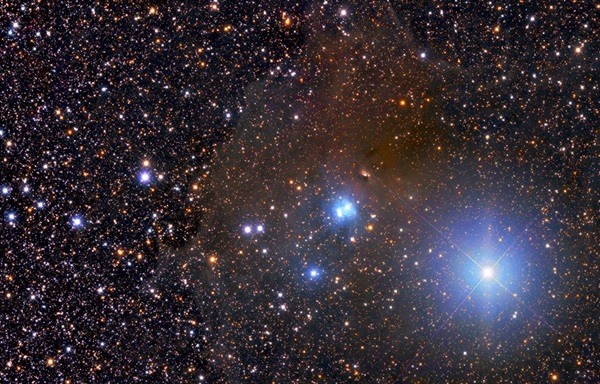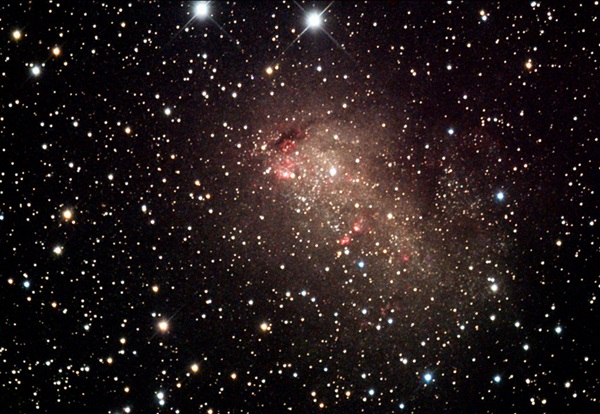Key Takeaways:
If that thought is not enough to warm your heart’s cockles, look to Beta (β) Cassiopeiae, the 2nd-magnitude star marking the Queen’s right hand in ancient Arab tradition. Its name, Caph, derives from the Arabic al-Kaff al-Khadib, which means “the Stained Hand.” (It might refer to the Arab practice of women painting their hands and feet with henna to protect their skin from the Sun’s heat.)
Of course, that leads us to a mystery. Why would Arabian astronomers have depicted a white F-type star as something with a reddish tint? I have never seen the reason discussed anywhere, but I have my own thoughts on the matter. Caph is the northernmost star in the bright W-shaped asterism, which is circumpolar from mid-northern latitudes, so the star never sets.
Two visual “beasts”
Despite the Queen’s visual allure, she hides among her milky folds two tiny deep-sky wonders that are truly “beastly” to see. Both are within 1.5° of her dyed right hand. They serve as tests of not only your sky’s darkness, but also the light grasp of your telescope and the keenness of your sight. Get ready to squint.
vdB 1: Only some 30′ east-southeast of Caph is one of the heavens’ least-known reflection nebulae — van den Bergh 1 (vdB 1). Searching for it with my 5-inch Tele Vue refractor has become one of my favorite winter sports. It’s a tiny glow only 5′ across, but that’s not what makes this nebula difficult to see. The problem is that its shine gets drowned out from the light of three 9th-magnitude stars in a roughly 5′-wide triangle. Any haze or moisture in the atmosphere will diminish your chances, especially if you’re using a small telescope.
If you’re using powers near 100x, I suggest first looking for the nebulosity surrounding the solitary 9th-magnitude sun at the northeastern end of the triangle. In case vdB 1 is not on your star chart, it’s located at right ascension 0h11m; declination 58°46′.
IC 10: While most observers recognize Cassiopeia for its wealth of nebulae and star clusters, it also has a galaxy within its boundaries: the little irregular system IC 10. Although the 10.3-magnitude galaxy lies only about 1½° from Caph, the 7′ by 6′-wide glow escaped the gaze of early telescopic pioneers until Lewis Swift discovered it October 8, 1887, with the 16-inch Clark refractor at Warner Observatory in Rochester, New York. Swift reported the discovery in an 1888 issue of Astronomische Nachrichten; it was one of 100 new nebulae found after the publication of the New General Catalogue. “For the most part,” Swift wrote, “they are exceedingly difficult objects, requiring exquisite seeing, prolonged scrutiny of the field, and an eye trained specially for the work.”
Based on my view of the galaxy, I would say take heed of Swift’s initial advice on the visual requirements necessary to see this dim and diffuse object. You’ll find it at right ascension 0h20m; declination 59°18′.
By the way, after Swift reported his discovery of IC 10, nearly half a century passed before Nicholas U. Mayall identified the “nebula” in 1935 as an extragalactic system. A year later, Edwin Hubble, who once called IC 10 “one of the most curious objects in the sky,” proposed that it might belong to the Local Group. Not until another 30 years had passed did radial velocity and distance measurements confirm Hubble’s suspicion.
Astronomers now know that IC 10 is an irregular galaxy 2.29 million light-years distant. Its morphology resembles that of the Large Magellanic Cloud. But whereas that object orbits our Milky Way Galaxy, IC 10 orbits the Andromeda Galaxy (M31). IC 10 is, in fact, the nearest starburst galaxy to us.
As always, let me know what you see, and don’t see, at someara@interpac.net.













